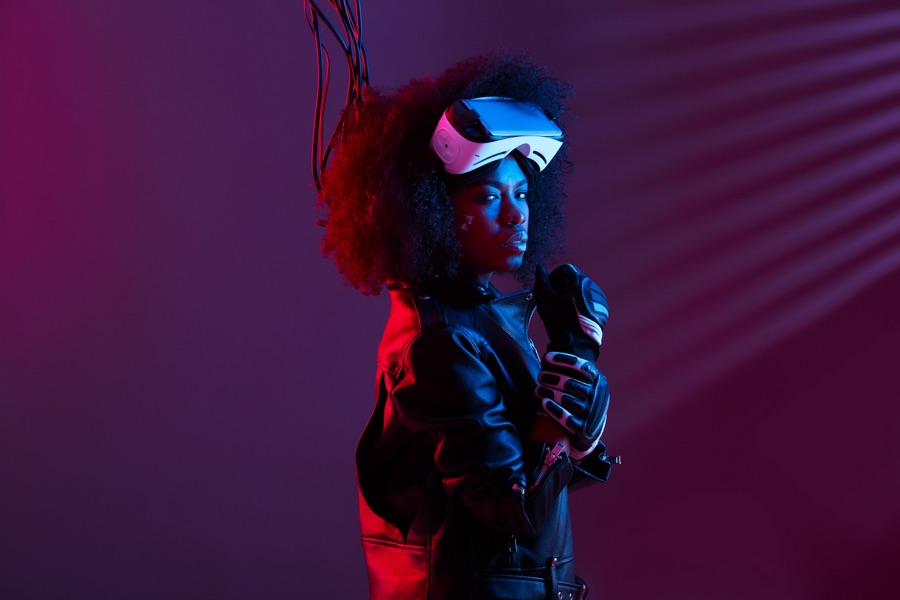Virtual fashion has been hovering on the margins of the industry for years now, but like many things, the pandemic helped speed its movement into the mainstream. In the last year alone, big influencers have made virtual fashion a more widely known concept and big brands have started experimenting with it in a more visible way. While still marginal to the overall industry, fashion insiders from a variety of brands believe it’s only a matter of time before virtual clothes turn into a very real trend.
The origins of virtual fashion
Virtual fashion is a term first coined by Robert Halfpenny, a writer and speaker for brands such as JCPenney, Old Navy and Sears. Virtual Fashionista, founded in 1997, was one of the first fashion blogs, and it’s hard to believe now. Those platforms came out when blogging was not a formalized industry, and people didn’t invest in creating good photography and styling, thus their garments didn’t look very good. A photo posted by Julia Dahlbeck (@julia_adahlbeck) on May 27, 2015 at 2:01pm PDT That led to the mainstream adoption of virtual clothing, which began in earnest in 2000 with the launch of IMVU, an online virtual world in which people could create and customize avatars.
Virtual Fashion Trends
“Technology is providing unprecedented creative possibilities. Some of the most extraordinary avatars are appearing on the web, where consumers create and personalize their own creations,” said David Jaramillo, senior director at Future Fashion Now, one of the world’s leading market research and trend forecasting agencies. Adidas.’ Black Panther’s T’Challa in the 2018 ‘Fashioning a Superhero’ line Adidas Two of the most prominent trendsetters in virtual fashion are Lil Miquela and Hatsune Miku. These two women have quickly become household names in their niche. Miquela is an Instagram model and influencer born in Miami with a large social media presence and a following of over 8 million people. Miku is a fictional avatar from the anime “Vocaloid,” created to produce music and games.
Augmented Reality
The growth of augmented reality is indisputable. The technology has already started transforming the way consumers shop and behave online. For now, designers can experiment with augmented reality using their own faces and from there, audiences can view the pieces before making a purchase. Adidas, for example, has been experimenting with AR in sneakers that are inspired by athletes and by Nicki Minaj, who has developed an AR shoe that has been showing up in her live performance. Last year, Brooklyn-based label Schutz also debuted AR sneakers that let viewers view what the shoe would look like on their feet. Dressing Room Earlier this year, Inditex revealed its tech-driven new virtual reality (VR) dressing room.
Virtual Reality

Virtual reality has the ability to transport users to an entirely different reality. Designers and brands are getting very creative with the possibilities that virtual reality provides and fashion designers in particular are always keen on trying to push the boundaries of what’s possible with the technology.
is becoming more commonplace and if you have a smartphone and some spare time, then it’s a good idea to download Cardboard, an app that lets you access virtual reality content using your smartphone. Simply take a look on Google Play to find it. Motion sensors are getting more and more affordable and VR technologies are increasingly being incorporated into clothing to create an interactive experience.
Examples include Gucci virtual sneakers, virtual handbags, and an app called Aglet where sneaker collectors can buy and collect digital sneakers that don’t exist in the real world.
What’s next?
While virtual fashion has shown great promise in improving consumer experience, apparel retailers have yet to fully embrace it. Only one in ten of them that Hmlet asked last month were already selling virtual clothes. But the outlook is improving. The future of virtual fashion looks bright, as more brands and retailers begin to pay attention. Next year, we could see a huge influx of virtual clothes hit the fashion retail scene. The European fashion industry is gearing up for Virtual Fashion Day, with online retail giant Asos in the lead. The company recently announced that it’ll start selling items from both High Fashion and mass market fashion brands through its Virtual Wardrobe service, from February 3rd until March 2nd.
The Future of Virtual Fashion
“It’s more and more that people are using virtual clothing in their daily lives,” says Andreas Kassab, CEO of the Copenhagen-based online footwear retailer LeKuid. “We use it as part of our logistics and to show store locations. It’s an integral part of how we do things today.” LeKuid’s extensive catalog, which includes more than 1,000 shoes and nearly 200 shoe styles, relies on a unique virtual model that allows it to easily show products in different settings—virtual stores, restaurants, or even on a tropical beach. “Shoes are kind of boring, so it’s nice to bring in some other things,” Kassab explains. Also available on its website is a virtual interior designed by Kartell, one of the world’s largest furniture manufacturers.
Conclusion
If the fashion industry follows the history of technology, virtual clothes will start to become more mainstream within the next few years. The big question is, will consumers be ready? Will they accept the ways that virtual clothes are being used in their daily lives? Just as with any kind of new technology, virtual clothes have a long way to go before we see them become mainstream. But, we can’t help but notice that today, the future of virtual clothing is looking bright.


